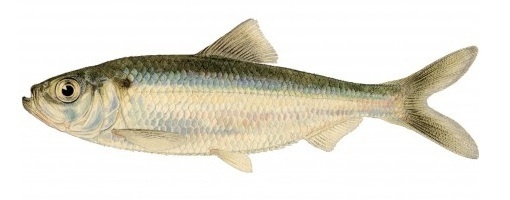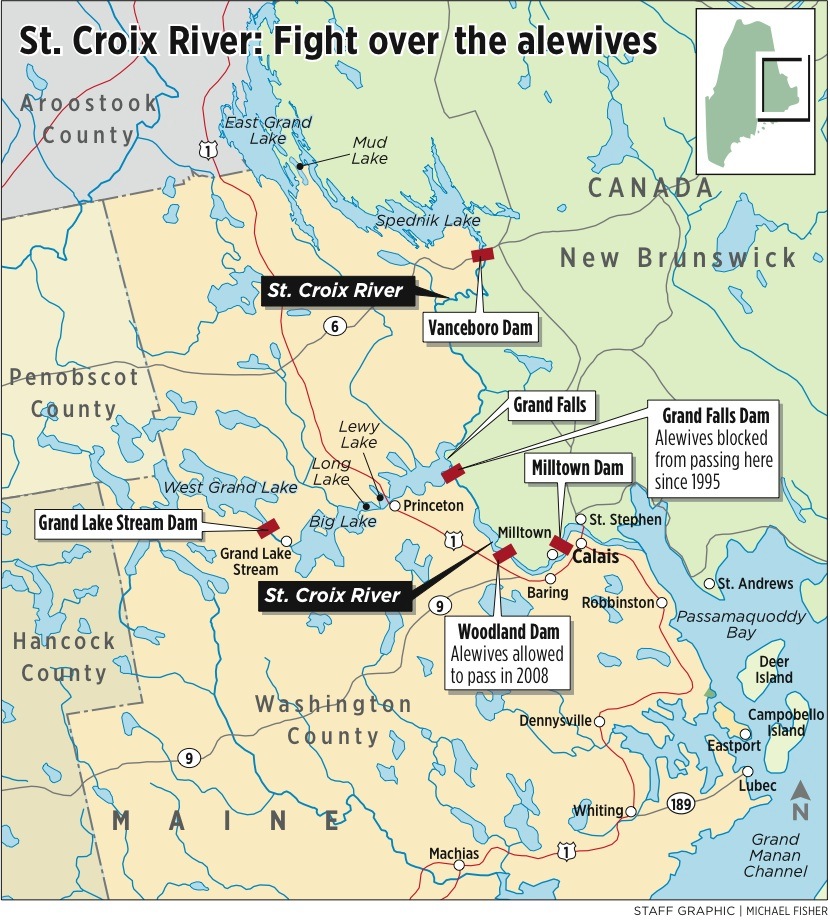The future of spawning alewife runs in the St. Croix River will likely be decided by state lawmakers next month as they evaluate rival bills aimed at allowing the fish back into the watershed.
The competing bills take very different approaches. One, introduced by Gov. Paul LePage’s administration, takes a slow and cautious tack to allowing the fish back into the river nearly two decades after they were locked out by state law. The other — backed by environmental groups, commercial fishermen and the Passamaquoddy Tribe — would open the dams immediately, a course of action endorsed by the federal governments of both the United States and Canada, whose territories the river system straddles.
Alewives, or “river herring,” are a small schooling fish that spend most of their life in the oceans but travel up freshwater rivers in spring to spawn. An important source of food for larger fish, their numbers crashed after dams were constructed on Maine’s rivers in the 19th century. Some scientists think their disappearance played a role in the destruction of Maine’s inshore cod stocks, and think their restoration to the Penobscot, St. Croix and other rivers could contribute to the recovery of commercial fish as well. But on the St. Croix, inland fishing guides fear the fish might harm smallmouth bass and other sportfish by competing for food.
“It is the Passamaquoddies’ vision that the entire watershed be available to river herring because it is an indigenous species and, like native peoples, they have been pushed back into smaller and smaller pieces of habitat,” said Paul Biscula, the former head of the Maine Indian Tribal-State Commission, who is acting as a spokesman for Passamaquoddy activists on the issue. “If we can restore the viability of river herring runs, valuable fish like cod will be able to feed on them.”
The LePage administration wants to implement a gradual, staged approach to reintroducing the spawning fish to the river. “I do not believe in one bit of my body that we will see a negative effect, but we want to do this in a way that tries to balance the polarization that has been part of the discussion on this issue since 1995,” said Patrick Keliher, commissioner of the Department of Marine Resources.
Alewives were effectively shut out of the river from 1825 to 1981, first because of impassable dams, and later because of pollution from lumber and paper mills. But from 1981 to 1987, their annual run grew 13-fold to more than 2.6 million.
In 1995, however, Augusta lawmakers passed a law that ordered the fishways at the Woodland and Grand Falls dams closed to the fish because inland fishing guides feared the alewives would harm the smallmouth bass populations in the region’s lakes and ponds. The St. Croix alewife runs collapsed to just 900 fish in 2002, a decline of 99.7 percent.
In 2008 the Legislature revisited the issue, but under pressure from guides and one faction of the Passamaquoddy Tribe, it ultimately decided to open only the Woodland Dam in Baileyville to the fish, depriving them of an estimated 94 percent of their habitat.
Last year, the U.S. Environmental Protection Agency directed the state to allow the alewives beyond Grand Falls, but then-Attorney General William Schneider countered that the agency’s ruling was irrelevant. The Conservation Law Foundation has sued the state in federal court to compel action.
Environmentalists and marine fisheries advocates say restoring the alewife population will benefit both the freshwater and marine ecosystems, because they are a source of food for smallmouth bass, cod and other species. One researcher estimated that if spawning runs were allowed access to the entire watershed, alewives could number more than 20 million, up from just over 31,000 now, with access confined to the lowest stretch of the river south of the Grand Falls Dam.
“There’s just no reason not to open the river,” said Nick Bennett, a staff scientist at the National Resources Council of Maine. “Alewives are good for everything, including smallmouth bass.”
Both bills before the Legislature would open more of the river to alewives, a move that local bass guides have long opposed, arguing the fish will compete with bass and other inland fish for food and that the fish are not native to the river.
Archaeological, documentary and topographic evidence suggests alewives were native to much of the watershed prior to the first, fish-impassable dams being built in 1825, a conclusion that has been endorsed by the government of Canada and the St. Croix board of the International Joint Commission, an international body that negotiates disputes on the shared waterway.
Early 19th-century alewife runs passing Calais and Milltown, New Brunswick, near the river’s mouth were described by witnesses as coming in “such quantities that it was supposed they never could be destroyed,” according to an official 1852 New Brunswick government report.
Numerous scientific studies show that smallmouth bass — which were introduced into the St. Croix in 1877 — have lived harmoniously with spawning alewives in hundreds of Maine rivers and lakes.
State Rep. Madonna Soctomah, who represents the Passamaquoddy Tribe in the Legislature, is the lead sponsor of L.D. 72, an emergency bill that would require the Grand Falls Dam fishway be opened to the “unconstrained passage of river herring” by May 1, in advance of the species’ spring spawning run. This would immediately allow the fish access to more than 24,000 acres of habitat, compared to 1,174 today, and would likely lead Canada to open the fishway at the Vanceboro dam farther upstream — which they control — opening up thousands more acres.
The administration’s bill — which has yet to be assigned a number — would also open the dam, but in accordance with the principals of the Adaptive Management Plan, a compromise protocol that would allow a phased introduction of the alewives into the middle watershed.
Developed under the auspices of the International Joint Commission several years ago, the international plan prohibits alewives them from passing the next set of dams at Vanceboro (on the main river) and Grand Lake Stream (on the western branch). Biologists would carefully monitor the situation, stepping in to close fishways if alewives appeared to cause trouble at certain densities.
Keliher said the strategy would be to allow a controlled number of fish beyond Grand Falls for several years, presumably demonstrating they do no harm. Later, the state could evaluate whether alewives should also be allowed beyond Vanceboro. The Grand Lake Stream fishway would remain closed to prevent the alewives from disrupting operations at the state fish hatchery above the dam.
The administration’s approach would work only if Canada could be persuaded to keep the Vanceboro dam’s fishway closed. This may be a tall order. In December, Canada’s foreign ministry wrote the State Department to express its desire for “the immediate reopening of all fishways” and expressing their desire “to open the Vanceboro Dam fishway to re-introduce alewives into Spednic Lake.”
The Canadian Department of Fisheries and Oceans wrote LePage on Dec. 14, encouraging him to “consider a more accelerated timeframe” for reintroducing the fish than that contained in the Adaptive Management Plan. Keliher said the administration did not consider the Adaptive Management Plan’s numbers to be set in stone.
Environmental groups say the governor’s bill represents an unnecessary concession to unsubstantiated concerns and will needlessly delay realization of economic and environmental benefits. The alewives are thought to be forage for cod and other groundfish and provide a source of bait for lobstermen.
“We don’t have an inshore groundfishery anymore, and one of the reasons is that we cleaned out the forage fish,” said Sean Mahoney, vice president of the Conservation Law Foundation. “The idea of limiting the abundance of natural resources on the basis of concerns that have no scientific support whatsoever is just really bad policy.”
The state’s largest guides’ association is supporting the administration’s approach. “Our concern is that if the biologists are wrong — and they can be — then we need a process to review and then react, and just opening the dam is not the best way to proceeed in our view,” said Don Kleiner, executive director of the Maine Professional Guides Association. “Caution makes a lot of sense here.”
Other guides remain concerned about letting the alewives into the river at all.
“I am not against alewives — if they were here before that would be one thing, but they weren’t,” said Lance Wheaton of The Village Camps in Forest City, whose family has been guiding fishermen in the St. Croix watershed for four generations.
“I wonder if the people and organizations who want to open the upper river to these fish will be ready to pay for the lost livelihoods of the families who would lose everything if they find out they’ve made a mistake.”
Colin Woodard can be contacted at 791-6317 or at:
cwoodard@pressherald.com
Send questions/comments to the editors.




Comments are no longer available on this story